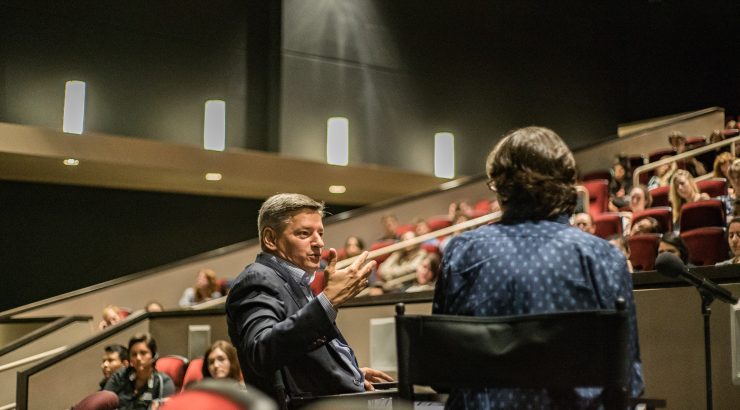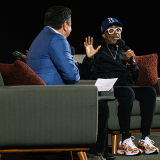
An Evening with Netflix CCO Ted Sarandos
September 29, 2017
Netflix can make any kind of content, and does so with purpose. With a healthy mix of cerebral dramas and stress-free comedies, it seeks to make and license shows for everybody and every mood they are in. There are shows that are for children and shows that cater to a senior demographic. “We don’t want every show to define our brand or our brand to define a show,” says Ted Sarandos, Chief Content Officer for Netflix. After having dinner with a select group of Dodge students and screening a yet to be streamed episode of a Netflix Original series, Sarandos spoke to the New Era of Television class about the company’s first steps into original programming and its current approach.
For those who may be too young to remember, Netflix began as subscription service that allowed customers to rent DVDs online. By 2007, Netflix started streaming content online. Sarandos explained that they knew other networks would stop selling to Netflix once they started to view it as competition. When that time would inevitably come, Netflix wanted to be able to hold their own. In February 2013, Netflix premiered its first original content, House of Cards. This cerebral political drama marks a turning point in TV history because it was written specifically for Netflix’s streaming format. Every show on Netflix up to that point had been reruns, produced to be watched each week. But Netflix knew that viewers watched their content in much longer blocks. The average watching session on Netflix is 2 hours and 10 minutes. With that in mind, Netflix skipped the episode recaps and repetition. House of Cards was written to be binged.
A student asked Sarandos if releasing an original series was intimidating. He explains, “We had a lot of confidence in what we were doing. There is so much content on Netflix that if you don’t watch one thing, it doesn’t affect much.” This took a good deal of pressure off of the series. Netflix does not rely on ratings to gauge success. “All of your watching is valuable to us.” Sarandos compares this method to the 7 day network viewing cut off. No matter when a show is watched, the views still contribute to maintaining subscriptions or generating new subscriptions. In traditional networks, creatives rely on ratings to understand the audience’s response. At Netflix, creatives are given specific feedback based on exact audience retention and viewer demographics. Otherwise, creatives can track their show’s success by knowing if they are “in the culture.” They know the show is doing well if they notice people talking about it or the show gets Emmy nominations. Case in point Stranger Things, created by Chapman alums the Duffer brothers. The show was nominated for 18 Emmys and won 5.
Without being tied down by a strict rating system, Netflix does not have to make every single show cater to everyone. “I like to think we’re as adventurous as we can be… Yes, there’s more shows but there’s also a higher chance that there’s a show that you love and relate to but the person next to you doesn’t like.” Shows like Orange is the New Black and Thirteen Reasons Why and Sense8 could not possibly get enough views to stay afloat on typical networks. “Something that’s small and niche doesn’t have to be bad [cheap]. Subscriptions support niche shows… Every month that we’re adding programming, we’re adding new users.” With 50.85 million U.S. streaming subscriptions, Netflix is climbing above and beyond traditional cable companies. In only 5 years, Netflix has drastically revolutionized the television world, changing the way content is watched and produced.

